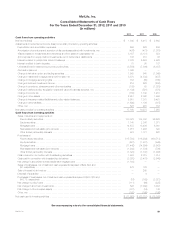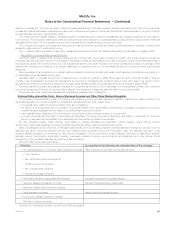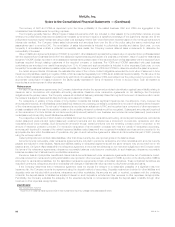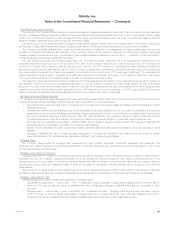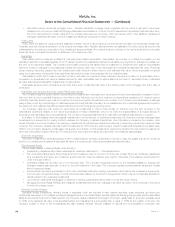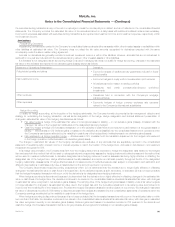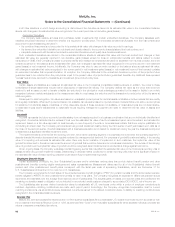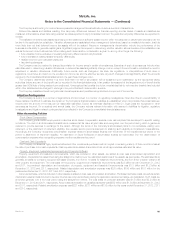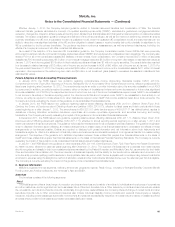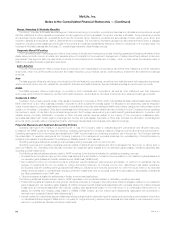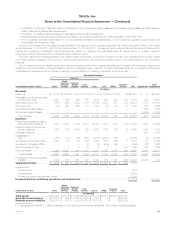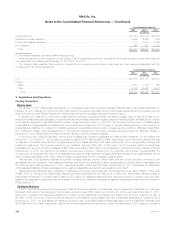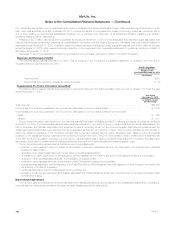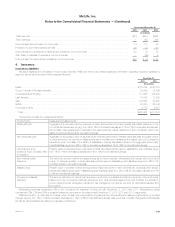MetLife 2012 Annual Report Download - page 99
Download and view the complete annual report
Please find page 99 of the 2012 MetLife annual report below. You can navigate through the pages in the report by either clicking on the pages listed below, or by using the keyword search tool below to find specific information within the annual report.
MetLife, Inc.
Notes to the Consolidated Financial Statements — (Continued)
The Company’s accounting for income taxes represents management’s best estimate of various events and transactions.
Deferred tax assets and liabilities resulting from temporary differences between the financial reporting and tax bases of assets and liabilities are
measured at the balance sheet date using enacted tax rates expected to apply to taxable income in the years the temporary differences are expected to
reverse.
The realization of deferred tax assets depends upon the existence of sufficient taxable income within the carryback or carryforward periods under the
tax law in the applicable tax jurisdiction. Valuation allowances are established when management determines, based on available information, that it is
more likely than not that deferred income tax assets will not be realized. Factors in management’s determination include the performance of the
business and its ability to generate capital gains. Significant judgment is required in determining whether valuation allowances should be established, as
well as the amount of such allowances. When making such determination, consideration is given to, among other things, the following:
‰future taxable income exclusive of reversing temporary differences and carryforwards;
‰future reversals of existing taxable temporary differences;
‰taxable income in prior carryback years; and
‰tax planning strategies.
The Company may be required to change its provision for income taxes in certain circumstances. Examples of such circumstances include when
estimates used in determining valuation allowances on deferred tax assets significantly change or when receipt of new information indicates the need for
adjustment in valuation allowances. Additionally, future events, such as changes in tax laws, tax regulations, or interpretations of such laws or
regulations, could have an impact on the provision for income tax and the effective tax rate. Any such changes could significantly affect the amounts
reported in the consolidated financial statements in the year these changes occur.
The Company determines whether it is more likely than not that a tax position will be sustained upon examination by the appropriate taxing
authorities before any part of the benefit can be recorded in the financial statements. A tax position is measured at the largest amount of benefit that is
greater than 50% likely of being realized upon settlement. Unrecognized tax benefits due to tax uncertainties that do not meet the threshold are included
within other liabilities and are charged to earnings in the period that such determination is made.
The Company classifies interest recognized as interest expense and penalties recognized as a component of income tax.
Litigation Contingencies
The Company is a party to a number of legal actions and is involved in a number of regulatory investigations. Given the inherent unpredictability of
these matters, it is difficult to estimate the impact on the Company’s financial position. Liabilities are established when it is probable that a loss has been
incurred and the amount of the loss can be reasonably estimated. Except as otherwise disclosed in Note 21, legal costs are recognized in other
expenses as incurred. On a quarterly and annual basis, the Company reviews relevant information with respect to liabilities for litigation, regulatory
investigations and litigation-related contingencies to be reflected in the Company’s consolidated financial statements.
Other Accounting Policies
Stock-Based Compensation
The Company grants certain employees and directors stock-based compensation awards under various plans that are subject to specific vesting
conditions. The cost of all stock-based transactions is measured at fair value at grant date and recognized over the period during which a grantee is
required to provide services in exchange for the award. Although the terms of the Company’s stock-based plans do not accelerate vesting upon
retirement, or the attainment of retirement eligibility, the requisite service period subsequent to attaining such eligibility is considered nonsubstantive.
Accordingly, the Company recognizes compensation expense related to stock-based awards over the shorter of the requisite service period or the
period to attainment of retirement eligibility. An estimation of future forfeitures of stock-based awards is incorporated into the determination of
compensation expense when recognizing expense over the requisite service period.
Cash and Cash Equivalents
The Company considers all highly liquid securities and other investments purchased with an original or remaining maturity of three months or less at
the date of purchase to be cash equivalents. Cash equivalents are stated at amortized cost, which approximates estimated fair value.
Property, Equipment, Leasehold Improvements and Computer Software
Property, equipment and leasehold improvements, which are included in other assets, are stated at cost, less accumulated depreciation and
amortization. Depreciation is determined using the straight-line method over the estimated useful lives of the assets, as appropriate. The estimated life is
generally 40 years for company occupied real estate property, from five to 10 years for leasehold improvements, and from three to seven years for all
other property and equipment. The cost basis of the property, equipment and leasehold improvements was $2.5 billion at both December 31, 2012
and 2011. Accumulated depreciation and amortization of property, equipment and leasehold improvements was $1.3 billion and $1.2 billion at
December 31, 2012 and 2011, respectively. Related depreciation and amortization expense was $208 million, $199 million and $151 million for the
years ended December 31, 2012, 2011 and 2010, respectively.
Computer software, which is included in other assets, is stated at cost, less accumulated amortization. Purchased software costs, as well as certain
internal and external costs incurred to develop internal-use computer software during the application development stage, are capitalized. Such costs are
amortized generally over a four-year period using the straight-line method. The cost basis of computer software was $1.5 billion and $2.2 billion at
December 31, 2012 and 2011, respectively. Accumulated amortization of capitalized software was $932 million and $1.5 billion at December 31, 2012
and 2011, respectively. Related amortization expense was $221 million, $217 million and $189 million for the years ended December 31, 2012, 2011
and 2010, respectively.
MetLife, Inc. 93


